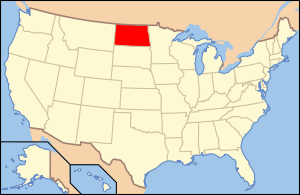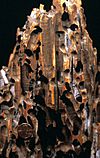Paleontology in North Dakota facts for kids

Paleontology in North Dakota is all about finding and studying fossils in the U.S. state of North Dakota. Long, long ago, during the early Paleozoic era, most of North Dakota was covered by a warm, shallow sea. This sea was home to many creatures like brachiopods (shellfish), corals, and early fish.
The sea left for a short time during the Silurian period but soon came back. It started to disappear again during the Permian period. By the Triassic period, some parts of the state were still under shallow water, but other areas were dry and very hot.
During the Jurassic period, subtropical forests grew across the state. North Dakota was always at least partly under seawater during the Cretaceous period. On land, giant Sequoia trees grew.
Later, in the Cenozoic era, the seas dried up. They were replaced by warm, wet swamps. The climate slowly got colder until the Ice Age. During the Ice Age, huge glaciers moved into the area. Mammoths and mastodons, which were like giant elephants, roamed the local woodlands.
Long ago, Native Americans in the area had their own ideas about fossils. They thought fossils were the remains of a water monster called Unktehi. Or, they believed they were snakes that burrowed into the ground and were killed by the powerful thunderbirds.
The first fossils from North Dakota that scientists wrote about were collected during the famous Lewis and Clark Expedition. Today, shipworm-bored petrified wood is the official state fossil of North Dakota.
Contents
North Dakota's Ancient Past
North Dakota does not have any Precambrian fossils. This means its fossil record starts later, during the Paleozoic era. During the early Paleozoic, large parts of North Dakota were under the sea. The sea briefly left during the Silurian period but quickly returned.
Life in this ancient sea included brachiopods, corals, fish, and molluscs. Sea levels kept changing throughout the rest of the Paleozoic era. By the Permian period, large areas of the state were dry land. At the end of the Paleozoic, North Dakota was located near the equator.
Life in the Mesozoic Era
During the Triassic period, much of North Dakota was covered by shallow seawater. But the dry land areas were very hot and dry. As the Triassic ended and the Jurassic began, North Dakota became a land of plains covered in subtropical forests.
Eventually, these forests were also covered by the sea again. This sea was home to creatures like bivalves (like clams), echinoderms (like starfish), tiny foraminiferans, and gastropods (like snails).
Throughout the entire Cretaceous period, North Dakota was either fully or partly under seawater. The Niobrara Formation, found in areas like the Pembina Escarpment and Valley City, has fish fossils from the Cretaceous. These fossils include their scales and bones.
The Cretaceous Pierre Shale rock layer is also found in the Pembina Escarpment and Valley City areas. You can also see it along the banks of the Missouri River and Little Missouri River. The Pierre Shale holds fossils of later Cretaceous invertebrates. These include ammonites (shelled creatures), clams, and snails. Fish from this time also left behind their scales.
Giant mosasaurs, which were marine reptiles, swam in the Late Cretaceous seas of North Dakota. On land, dinosaurs lived along the coast of this sea. Later in the Cretaceous, vertebrates (animals with backbones) left behind fossil bones in North Dakota. Sometimes, even impressions of leafs from the local flora (plants) were preserved in the Hell Creek Formation. These fossils are found near the Missouri and Little Missouri rivers.
The Cretaceous Sequoia dakotensis tree left fossil cones near Mandan. The same place has pieces of petrified wood, some weighing up to 50 pounds. Some of this petrified wood has holes made by ancient ship worms. Dinosaurs found here included the armored Edmontonia, the duck-billed Edmontosaurus, ostrich dinosaurs, pachycephalosaurs (dome-headed dinosaurs), Triceratops, and Tyrannosaurus.
The Cenozoic Era and Ice Age
During the Paleocene epoch, corals and snails were preserved in rocks now called the Cannonball Formation. However, these fossils are very rare. Freshwater clams and snails have also been found in other rocks from this time in the state.
On land, trees left behind wood that turned into petrified wood. Leaves are also found among North Dakota's Paleocene fossils. Eocene plant fossils are known along the Knife River. Freshwater clams and snails are found north and east of the Missouri River. The Cannonball deposits near Minot are the last signs of a sea in the middle of North America.
As the Cenozoic era continued, North Dakota's sea disappeared. It was replaced by subtropical swamps. North Dakota's rich forests included plants like cycads, dawn redwoods, ferns, figs, and palms. These plants left behind huge coal deposits in the rocks.
Throughout the rest of the Cenozoic, North Dakota's climate became cooler and drier. The state's swamps vanished, and the animals living there died out. In their place, woodlands grew. The climate got even colder, and eventually, glacial activity changed the state's landscape. During this time, North Dakota was home to giant mammoths and mastodons.
Discovering North Dakota's Fossils
Early Explorers and Scientists
The first fossils in North Dakota that scientists wrote about were collected by the Lewis and Clark Expedition. This happened between 1804 and 1806 as they explored the Missouri River. The first fossil written about was petrified wood found in sandstone rocks near the Cannonball River.
In 1833, a German explorer named Alexander Philip Maximilian saw leaf impressions in sandstone along the upper Missouri River. He thought these ancient plants looked like modern plants growing there. Maximilian collected many of them, but in 1835, his fossils were destroyed in a fire on a steamship near what is now Bismarck. In 1843, John James Audubon collected fossils like petrified wood and sea shells in the area, but they were not very good quality.
In the mid-1800s, the U.S. government started exploring the upper Missouri region in detail. A geologist named John Evans, who worked for the Northern Pacific Railroad Survey, said the area between the Sioux River and the Falls of the Missouri was one of the best places in the world to find Cretaceous and Tertiary fossils.
Evans sent fossils of animals with backbones to Joseph Leidy. Leidy wrote important papers about these remains. Other key people in early North Dakota paleontology were Dr. Ferdinand V. Hayden and Dr. Fielding Bradford Meek. New York geologist W. James Hall became interested in North Dakota fossils because of Evans and Leidy's work. Hall sent Hayden and Meek to the area. Their trip was very successful, and they "collected an enormous quantity of fossils." Hall and Meek described the non-mammal fossils, while Leidy described the mammals.
Later Discoveries
In 1883, Edward Drinker Cope began his work in North Dakota. One of his first achievements was describing two new types of fish from the White River Formation. The place where Cope found these fossils became so famous that all its fossils were collected, and the site was "completely mined out."
In 1905, Earl Douglass wrote a lot about the fossils in the region near Cope's work for the Carnegie Museum. In the summer of 1963, Charles I. Frye found a Triceratops skeleton in the Hell Creek Formation of Slope County, near Marmarth. At the time, it was considered the best Triceratops skeleton ever found. Many groups, both state and national, helped pay for the digging of this fossil. Among those who helped dig were Dr. Holland, Jack W. Crawford, and Michael F. Archbold from the Department of Geology at the University of North Dakota in Grand Forks. Marshall Lambert from Ekalaka, Montana, also helped. Between 1963 and 1966, several important Pleistocene mammal skulls were found in North Dakota and written about in scientific papers.
Famous Fossil Hunters
Charles Lewis Camp was born in Jamestown on March 12, 1893.
Where to See Fossils
- Dakota Dinosaur Museum, Dickinson



